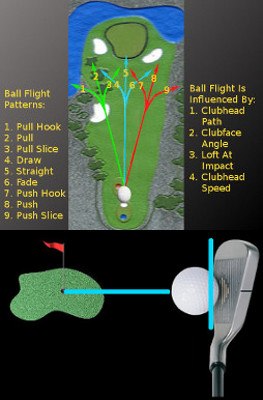You're Correct!
 They give you valuable information on why the ball flight is as it is and help you to understand what is happening at impact, so that you can relate that to what you then see the ball doing when it flies.
They give you valuable information on why the ball flight is as it is and help you to understand what is happening at impact, so that you can relate that to what you then see the ball doing when it flies.
If you look at your golf clubs, you will see that there are strike marks from where the ball has struck the club face. These marks and their position on the club head will give you information as to what is happening at impact, when the club head strikes the ball. For example, if you see a shot that is going really low and over to the right, you will see a mark on the hosel - that is where the shaft connects into the club head and you are basically hitting a shank, if you are a right hand golfer.
If see the ball flying off to the right, but much higher this time, if you look at your club head you will see that the golf ball is leaving strike marks on the club face, over towards the toe - that is the very far end of the golf club face. As the club face connects with the golf ball on the toe, the toe end of the club face slows down due to the impact with the golf ball, but the heel end of the club face, the end closest to you, keeps travelling at the original speed through impact. As a result of this, the club face opens and aims right of the target, producing a shot that flies to the right. As the face opens, the loft on the club face also increases as a result and the shot therefore flies high as well.
If you notice that all the club face marks on your club face are towards the heel, so that is the nearer end of the club, then you will notice that all your shots will be flying over to the left, This is because the club head is impacting with the golf ball and therefore slowing the heel end of the club face down. The toe end of the club face continues to travel at a higher speed as it is not impacting with anything and as a result it accelerates past the heel and closes the face. As a product of this, you will end up hitting the ball over to the left.
You can gain further information from your woods. If you look at your woods and you notice you have got marks on the very top of the club, the very upper part of the face and the crown surface, the very top surface of the club head, this is an indicator for why the ball is going so high - your tee peg is too high and the club head is swinging through impact and striking the ball too high up on the club face. Tee the ball down a little bit lower and you should find that you get a more centred strike and a low, more penetrating ball flight, that produces a longer shot.
Remember on every shot you are looking to strike the golf ball from the centre of the golf club face. Look at what information is left on the club head and on the club face, from its impact with the golf ball and it will really help you to learn what is happening at impact. You can then alter the strike position accordingly, for example, by standing closer or further away, teeing the ball down and getting the strike closer to the middle. Try that the next time you practise, have a look at where the marks are on your golf club face and it should really help you to understand why the ball is reacting the way it is and then you can learn from that and alter where you are seeing the strike mark so it becomes more centred and you hit better golf shots.
Sorry Try Again! - See Explanation Below
Not all areas on the club face are equal. It is essential for accurate and well controlled golf shots that the strike is located as close to the centre as possible.
Sorry Try Again! - See Explanation Below
Striking a ball towards the heel can be dangerous as it is risking hitting the curved neck/shank section of the golf club which will result in a shot that shoots low and to the right.
Sorry Try Again! - See Explanation Below
The marks that are left on your club head once you strike a golf ball provide extremely valuable information about where the club head connected with the golf ball. Thinking the marks mean nothing is completely wrong. You can learn valuable lessons about why the ball is flying the way you are observing from looking at the marks left on the club head.






